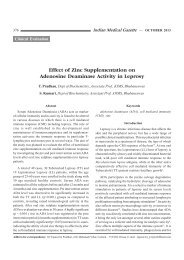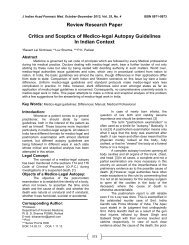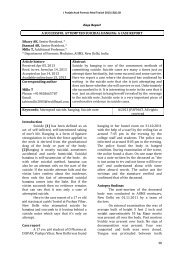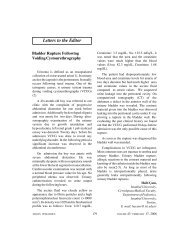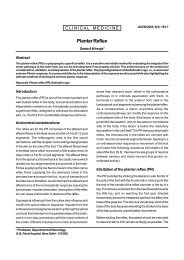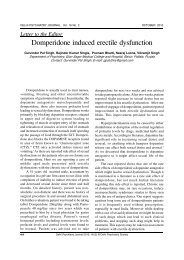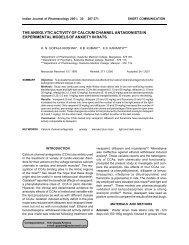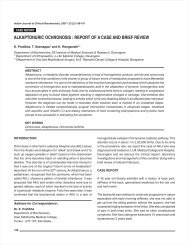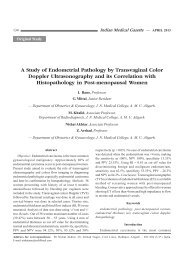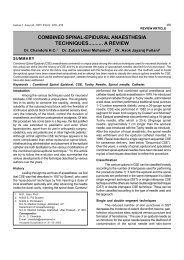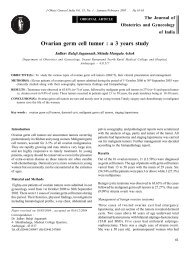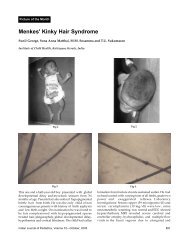Clinical Safety and Efficacy of Pilex Tablets and Ointment ... - medIND
Clinical Safety and Efficacy of Pilex Tablets and Ointment ... - medIND
Clinical Safety and Efficacy of Pilex Tablets and Ointment ... - medIND
You also want an ePaper? Increase the reach of your titles
YUMPU automatically turns print PDFs into web optimized ePapers that Google loves.
eVIew artICle<br />
<strong>Clinical</strong> <strong>Safety</strong> <strong>and</strong> <strong>Efficacy</strong> <strong>of</strong> <strong>Pilex</strong> <strong>Tablets</strong> <strong>and</strong><br />
<strong>Ointment</strong> in the Management <strong>of</strong> Hemorrhoids<br />
dIbyendu gautam*, manasI basu banerJee**, shIb shankar roy Chowdhury † , JaydeV PramanIk ‡<br />
AbSTRACT<br />
Hemorrhoids are an abnormal swelling <strong>of</strong> the blood vessels in the anal canal; treatment is indicated only when they become<br />
symptomatic. Conservative treatment typically consists <strong>of</strong> increasing dietary fiber, oral fluids to maintain hydration, nonsteroidal<br />
anti-inflammatory drugs (NSAIDs), sitz baths <strong>and</strong> rest. Surgery is indicated when conservative treatment fails;<br />
but, the results are <strong>of</strong>ten unsatisfactory <strong>and</strong> recurrence may occur. However, in the general management <strong>of</strong> hemorrhoids,<br />
colorectal surgeons agree that severe painful thrombosed hemorrhoids should be excised. The main ingredients <strong>of</strong> <strong>Pilex</strong> tablet<br />
are Terminalia chebula, Cassia fistula, Emblica <strong>of</strong>ficinalis, which improve appetite, correct hepatic function <strong>and</strong> have mild laxative<br />
properties thereby facilitating bowel evacuation <strong>and</strong> reducing local trauma to the hemorrhoidal vessels. The main ingredients<br />
<strong>of</strong> <strong>Pilex</strong> ointment are Mimosa pudica, Vitex negundo, Eclipta alba <strong>and</strong> Solanum nigrum. These herbs possess styptic <strong>and</strong> antiinflammatory<br />
properties <strong>and</strong> help in regeneration <strong>of</strong> the vascular endothelium. <strong>Pilex</strong> tablets orally <strong>and</strong> ointment locally have<br />
been very favorably reported for the amelioration <strong>and</strong> treatment <strong>of</strong> piles in various clinical trials <strong>and</strong> also established by a<br />
large number <strong>of</strong> clinicians <strong>and</strong> surgeons. This review summarizes the effects <strong>of</strong> the polyherbal formulations <strong>Pilex</strong> tablets <strong>and</strong><br />
ointment in patients <strong>of</strong> hemorrhoids.<br />
keywords: <strong>Pilex</strong> tablets, <strong>Pilex</strong> ointment, hemorrhoids<br />
Hemorrhoids, or piles, as they are commonly<br />
known as, have plagued humankind since<br />
ancient times. On the day <strong>of</strong> the decisive battle<br />
at Waterloo, Napoleon Bonaparte was in pain because<br />
<strong>of</strong> a severe case <strong>of</strong> thrombosed hemorrhoids, which<br />
impaired his battlefield conduct. 1<br />
Hemorrhoids are an abnormal swelling in the blood<br />
vessels in the anal canal. The most common symptom<br />
is bright red blood in stool. Other symptoms range<br />
from itchiness, pain, swelling, protrusion, bleeding,<br />
constipation <strong>and</strong> difficulty evacuating, to large fungating<br />
masses or prolapsed piles. 2 These symptoms occur<br />
due to a vicious circle <strong>of</strong> events. Vascular, submucosal<br />
cushions protrude through a tight anal canal, become<br />
further congested by the sphincter <strong>and</strong> hypertrophy so<br />
that they then protrude more easily. Management <strong>of</strong><br />
hemorrhoids is directed at breaking this circle.<br />
There are two types <strong>of</strong> hemorrhoids, external <strong>and</strong><br />
internal, according to their position with respect to the<br />
dentate line. 3 The internal hemorrhoids develop within<br />
*Pr<strong>of</strong>essor, Dept. <strong>of</strong> Surgery<br />
**Associate Pr<strong>of</strong>essor, Dept. <strong>of</strong> Pharmacology<br />
† Associate Pr<strong>of</strong>essor, Dept. <strong>of</strong> Surgery<br />
Medical College <strong>and</strong> Hospital, Kolkata<br />
‡ Ayurvedic Consultant<br />
Kawagachhi Gramin Health <strong>and</strong> Research Centre, Parganas, West Bengal<br />
address for correspondence<br />
Pr<strong>of</strong>. Dibyendu Gautam, Dept. <strong>of</strong> Surgery<br />
Medical College <strong>and</strong> Hospital, Kolkata, West Bangal<br />
E-mail: drdivyendu@gmail.com<br />
the anus beneath the lining. An internal hemorrhoid<br />
can cause severe pain if it is completely prolapsed. 4<br />
The external hemorrhoids develop near the anus <strong>and</strong><br />
are covered by very sensitive skin. If a blood clot<br />
(thrombosis) develops in an external hemorrhoid,<br />
it becomes a painful, hard lump <strong>and</strong> may bleed if it<br />
ruptures. 5 Internal hemorrhoids are classically divided<br />
into four categories (I-IV) based on the degree <strong>of</strong><br />
prolapse. Recently, it has been suggested that it is<br />
more appropriate to classify them on the basis <strong>of</strong><br />
presence or absence <strong>of</strong> bleeding or prolapse. 6<br />
The prevalence <strong>of</strong> symptomatic hemorrhoids ranges<br />
from 4.4% in the general population to 36.4% in general<br />
practice. 7 The pathophysiology is not completely<br />
understood other than that structural <strong>and</strong> vascular<br />
changes are involved. 8 A detailed history is important.<br />
Besides the routine physical examination (visual<br />
inspection <strong>of</strong> the anal region, digital examination,<br />
anoscopy), patients 50 years, patients <strong>of</strong> any age with bleeding<br />
<strong>and</strong> anemia, those with persistent bleeding despite<br />
medical therapy, select patients with significant family<br />
history <strong>of</strong> colorectal malignancy <strong>and</strong> those with other<br />
symptoms such as abdominal pain <strong>and</strong> bloating <strong>and</strong><br />
diarrhea. 9 Treatment is only indicated if they become<br />
symptomatic. But, colorectal surgeons agree that all<br />
painful thrombosed hemorrhoids should be excised.<br />
Conservative treatment typically consists <strong>of</strong> increasing<br />
Indian Journal <strong>of</strong> <strong>Clinical</strong> Practice, Vol. 22, No. 9, February 2012<br />
443
eVIew artICle<br />
dietary fiber, oral fluids to maintain hydration,<br />
analgesics, sitz baths <strong>and</strong> rest. 3 Increased fiber intake<br />
improves outcomes. 10 There is scant evidence to<br />
support use <strong>of</strong> topical agents <strong>and</strong> suppositories for<br />
treatment. 3 Steroid-containing agents should not be<br />
used for >14 days as they may cause thinning <strong>of</strong> the<br />
skin. 3 Hemorrhoidectomy is indicated for large third-<br />
<strong>and</strong> fourth-degree hemorrhoids, mixed hemorrhoids<br />
with a prominent external component <strong>and</strong> incarcerated<br />
internal hemorrhoids requiring urgent intervention.<br />
Hemorrhoids that fail to respond to medical<br />
management may be treated with rubber b<strong>and</strong> ligation,<br />
sclerosis <strong>and</strong> thermotherapy. Rubber b<strong>and</strong> ligation has<br />
been demonstrated to be the most effective method<br />
to treat symptomatic internal hemorrhoids that have<br />
failed conservative management. 11-14 Complications <strong>of</strong><br />
this procedure include vasovagal response, anal pain,<br />
bleeding from early dislodgment <strong>and</strong> pelvic sepsis. 15<br />
This review summarizes six clinical studies wherein <strong>Pilex</strong><br />
tablets <strong>and</strong> ointment were evaluated in hemorrhoids.<br />
PILEx TAbLET AND ITS PHARMACOLOGY<br />
<strong>Pilex</strong> tablets contains various herbs: Their pharmacological<br />
actions are as described below.<br />
Pharmacological Actions <strong>of</strong> Principal Herbs<br />
<br />
<br />
<br />
<br />
<br />
Balsamodendron mukul (Syn. Commiphora<br />
mukul): The guggulusterone fraction showed antiinflammatory<br />
activity, comparable to approximately<br />
one-fifth that <strong>of</strong> hydrocortisone <strong>and</strong> equal<br />
to phenylbutazone <strong>and</strong> ibupr<strong>of</strong>en. 16<br />
Shilajeet (Purified): It has been used as antiinflammatory<br />
agent. Results <strong>of</strong> its use in diabetes,<br />
fever, anemia, anorexia, spasmodic pain, obesity,<br />
abdominal disorders <strong>and</strong> skin diseases have been<br />
documented. It also has cardiotonic activity. 17,18<br />
Melia azadirachta (Syn. Azadirachta indica): The<br />
leaves <strong>and</strong> bark have antimicrobial, antifungal,<br />
anthelmintic, insecticidal, antiviral, antipyretic <strong>and</strong><br />
anti-inflammatory activities. It has been used in<br />
inflammatory gum diseases, boils, sores, measles,<br />
small pox <strong>and</strong> other cutaneous infections. 19,20<br />
Berberis aristata: The extract has bitter, cholagogue,<br />
antidiarrheal, stomachic, laxative, antipyretic <strong>and</strong><br />
antiseptic activities. It also has anti-inflammatory,<br />
hypotensive <strong>and</strong> antiamebic activities. 21 The<br />
laxative activity is useful in hemorrhoids. 22<br />
Emblica <strong>of</strong>ficinalis: It has antiviral, antibacterial<br />
<strong>and</strong> antiallergic activities <strong>and</strong> is rich in phenols.<br />
The aqueous extract has antibacterial activity<br />
444 Indian Journal <strong>of</strong> <strong>Clinical</strong> Practice, Vol. 22, No. 9, February 2012<br />
<br />
<br />
<br />
<br />
<br />
against Staphylococcus aureus. 23 It is useful in viral<br />
hepatitis, premature atherosclerosis, anemia, acne,<br />
fistula, etc. 24<br />
Terminalia chebula: It has antibacterial, antifungal<br />
activity against many dermatophytes <strong>and</strong> enhances<br />
immunity. It also has antispasmodic <strong>and</strong> potent<br />
wound healing activities. It is widely prescribed<br />
in constipation, ulcer, gastroenteritis, cough,<br />
hemorrhoids <strong>and</strong> other skin diseases. 25<br />
Terminalia belerica: It has hepatoprotective action. 26<br />
Being one <strong>of</strong> the ingredients <strong>of</strong> Triphala, T. belerica<br />
also has gastroprotective <strong>and</strong> laxative properties. 27<br />
Cassia fistula: It is used in conditions <strong>of</strong><br />
hematemesis, pruritus, leukoderma, diabetes<br />
<strong>and</strong> other common dermatological infestations,<br />
inflammatory disorders <strong>and</strong> constipation. 28<br />
C. fistula pod infusion has been safely utilized as a<br />
laxative <strong>and</strong> as a substitute for the <strong>of</strong>ficial Senna. 29<br />
Bauhinia variegata: It has laxative, antibacterial,<br />
blood purifying, antioxidant, antitumor <strong>and</strong><br />
hepatoprotective properties. 30,31<br />
Mesua ferrea: It has potent broad-spectrum<br />
antimicrobial actions. 32 Its astringent <strong>and</strong> styptic<br />
actions are useful in bleeding piles. 33<br />
<strong>Pilex</strong> <strong>Ointment</strong> <strong>and</strong> its Pharmacology<br />
<strong>Pilex</strong> ointment is a herbomineral formulation. The<br />
synergistic actions <strong>of</strong> constituent herbs reduce<br />
varicosities <strong>of</strong> venous plexus in hemorrhoids.<br />
<br />
<br />
<br />
<br />
Mimosa pudica: It’s astringent <strong>and</strong> styptic actions<br />
are useful in bleeding piles. 34<br />
Eclipta alba: It has anti-inflammatory <strong>and</strong> analgesic<br />
activities. 35<br />
Vitex negundo: It’s potent broad-spectrum<br />
antimicrobial action prevents secondary microbial<br />
infection. 36 V. negundo also has potent <strong>and</strong> directly<br />
dose-dependent analgesic, strong antihistamine<br />
activity (which helps to control associated itching),<br />
membrane stabilizing <strong>and</strong> antioxidant activities. 37,38<br />
Anti-inflammatory activity due to triterpenoids <strong>and</strong><br />
antihistamine activity have been demonstrated. 39<br />
Calendula <strong>of</strong>ficinalis: It has anti-inflammatory <strong>and</strong><br />
analgesic activities <strong>and</strong> accelerates wound healing<br />
by epithelial regeneration. 40 C. <strong>of</strong>ficinalis improves<br />
network <strong>of</strong> basal membrane collagenous substance,<br />
which re-normalizes the capillary membranes<br />
resistance. It subsequently induces reduction in<br />
the hemorrhoidal mass <strong>of</strong> the dilated veins <strong>of</strong><br />
hemorrhoidal plexus. 40 It also has potent free<br />
radical scavenging activities. 41
Cinnamomum camphora: It has analgesic activity<br />
<strong>and</strong> relieves pain by reducing sensitivity <strong>of</strong> the<br />
brain or nervous system to pain. 42 It accelerates<br />
wound healing by epithelial regeneration <strong>and</strong><br />
has potent broad-spectrum antimicrobial actions 43<br />
including free radical scavenging activities. 44<br />
Tankana: Its potent broad-spectrum antimicrobial<br />
actions prevent secondary microbial infections. 45<br />
Yashada Bhasma: It has potent anti-inflammatory<br />
<strong>and</strong> analgesic actions <strong>and</strong> accelerates wound<br />
healing by epithelial regeneration. 46<br />
<strong>Clinical</strong> Studies <strong>of</strong> <strong>Pilex</strong> Tablet <strong>and</strong> <strong>Ointment</strong><br />
<strong>Pilex</strong> has been put to stringent safety <strong>and</strong> tolerability<br />
evaluation. Six clinical studies are summarized below.<br />
Study 1: Indigenous drug therapy for hemorrhoids 47<br />
Material <strong>and</strong> methods: The study included 100<br />
patients with first- <strong>and</strong> second-degree uncomplicated<br />
hemorrhoids. Fifty patients were given a placebo;<br />
the remaining 50 patients were given <strong>Pilex</strong> therapy.<br />
Bleeding was the most common symptom in all the<br />
patients, followed by pain during/after defecation (92%)<br />
<strong>and</strong> mucus discharge (72%). A detailed history including<br />
digital examination <strong>and</strong> proctoscopy was done to<br />
exclude other causes <strong>of</strong> bleeding per rectum. Initially,<br />
<strong>Pilex</strong> tablets were given in a dose <strong>of</strong> two tablets thricedaily<br />
for 1 week, followed by two tablets twice-daily<br />
for 4 weeks. A maintenance dose <strong>of</strong> one tablet twicedaily<br />
was given till symptomatic relief was obtained.<br />
<strong>Pilex</strong> ointment was used in all as a supplement.<br />
Results<br />
<br />
<br />
<strong>Pilex</strong> Group: Fifty percent showed remarkable<br />
improvement in the form <strong>of</strong> complete cessation<br />
<strong>of</strong> bleeding, pain <strong>and</strong> discharge. Proctoscopy in<br />
these patients revealed significant shrinkage <strong>of</strong><br />
the pile masses <strong>and</strong> improvement in hemoglobin.<br />
Good response in the form <strong>of</strong> marked regression<br />
<strong>of</strong> bleeding, pain <strong>and</strong> discharge was seen in 26%<br />
<strong>of</strong> cases. The shrinkage <strong>of</strong> pile mass was to a lesser<br />
extent in these patients. Poor response, either<br />
subjectively or objectively, was seen in 24%.<br />
Placebo Group: In first-degree hemorrhoids,<br />
improvement was seen only in 20%. Ten percent<br />
showed some improvement in symptoms with<br />
some shrinkage <strong>of</strong> pile masses <strong>and</strong> reduction in<br />
discharge. Remaining 70% had a poor subjective<br />
or objective response in the follow-up period <strong>of</strong><br />
six months. Several <strong>of</strong> them later switched over<br />
to some other form <strong>of</strong> therapy like injection <strong>and</strong><br />
surgery as they were unwilling to continue.<br />
reVIew artICle<br />
Conclusion: Treatment with <strong>Pilex</strong> was highly satisfactory;<br />
it was unsatisfactory in the placebo group.<br />
Study 2: <strong>Pilex</strong> versus Daflon in hemorrhoids 48<br />
Material <strong>and</strong> methods: Thirty patients with Grades I,<br />
II <strong>and</strong> III <strong>of</strong> internal <strong>and</strong> external hemorrhoids were<br />
included in the trial. Patients with evidence <strong>of</strong> rectal<br />
prolapse, malignancy <strong>and</strong> systemic debilitating illness<br />
were excluded from the trial. All the patients were<br />
subjected to history taking <strong>and</strong> physical examination<br />
including digital examination <strong>and</strong> proctoscopy. Patients<br />
were divided into two groups <strong>of</strong> 15 each. Group A<br />
patients received <strong>Pilex</strong> tablets, two tablets thrice-daily<br />
after meals for 1 week, followed by two tablets twicedaily<br />
for 5 weeks. All the patients were advised to apply<br />
<strong>Pilex</strong> ointment twice-daily before <strong>and</strong> after evacuation<br />
<strong>of</strong> the bowel. Group B patients received Daflon tablets<br />
one tablet thrice-daily for 6 weeks. All the patients<br />
were examined at weekly intervals <strong>of</strong> six weeks for<br />
subjective evaluation, which was graded with scores:<br />
1 - Mild relief, 2 - Moderate relief <strong>and</strong> 3 - Complete<br />
relief. Objective evaluation was done at the beginning<br />
<strong>and</strong> at six weeks at end <strong>of</strong> study.<br />
Results<br />
Group A: Patients treated with <strong>Pilex</strong> tablet <strong>and</strong> ointment.<br />
<br />
<br />
<br />
Grade I: <strong>Pilex</strong> tablet <strong>and</strong> ointment was found<br />
very effective in controlling bleeding. About<br />
90% <strong>of</strong> patients reported complete recovery; on<br />
proctoscopy after four weeks <strong>of</strong> treatment, the<br />
mucosa was normal. Bleeding was checked within<br />
2-3 weeks <strong>of</strong> treatment. Shrinkage in piles gradually<br />
occurred over 3-4 weeks in 80%.<br />
Grade II: Moderate reduction in size <strong>and</strong><br />
inflammation on hemorrhoidal mass; bleeding was<br />
controlled in over 90% <strong>of</strong> cases.<br />
Grade III: Mild reduction in size <strong>and</strong> inflammation<br />
<strong>of</strong> hemorrhoid mass. But, bleeding stopped within<br />
four weeks <strong>of</strong> treatment.<br />
Group B: Patients treated with Daflon<br />
<br />
<br />
<br />
Grade I: More than 90% <strong>of</strong> patients responded in<br />
terms <strong>of</strong> bleeding per rectum. There was a mild<br />
decrease in size <strong>and</strong> inflammation <strong>of</strong> pile mass.<br />
Grade II: Bleeding was controlled in >90% <strong>of</strong> cases.<br />
Minimal to mild reduction in size <strong>and</strong> inflammation<br />
<strong>of</strong> mass was reported after 4-6 weeks <strong>of</strong> treatment.<br />
Grade III: Effective in controlling bleeding; minimal<br />
change in size <strong>and</strong> inflammation was reported.<br />
Conclusion: Daflon tablets <strong>and</strong> <strong>Pilex</strong> tablet <strong>and</strong><br />
ointment are equally effective in controlling bleeding,<br />
Indian Journal <strong>of</strong> <strong>Clinical</strong> Practice, Vol. 22, No. 9, February 2012<br />
445
eVIew artICle<br />
irrespective <strong>of</strong> the grade <strong>of</strong> hemorrhoids. Bleeding was<br />
checked in both the groups over a period <strong>of</strong> 2-3 weeks.<br />
<strong>Pilex</strong> tablet <strong>and</strong> ointment are better than Daflon tablet<br />
in reducing inflammation <strong>and</strong> size <strong>of</strong> hemorrhoidal<br />
mass in Grades I <strong>and</strong> II. <strong>Pilex</strong> tablet <strong>and</strong> ointment<br />
induced complete remission in most cases with Grade I<br />
hemorrhoids. They also had better efficacy in reducing<br />
pain than Daflon, in terms <strong>of</strong> early recovery.<br />
Study 3: Role <strong>of</strong> <strong>Pilex</strong> tablets <strong>and</strong> ointment in the<br />
treatment <strong>of</strong> piles <strong>and</strong> fissures 49<br />
Material <strong>and</strong> methods: One hundred eight cases <strong>of</strong><br />
piles, with/without anal fissures, were treated with<br />
a combination <strong>of</strong> <strong>Pilex</strong> tablets <strong>and</strong> <strong>Pilex</strong> ointment for<br />
six weeks; for the first two weeks with 2 tablets <strong>of</strong><br />
<strong>Pilex</strong> thrice-daily orally <strong>and</strong> <strong>Pilex</strong> ointment applied<br />
locally twice-daily (at bedtime <strong>and</strong> in the morning<br />
after defecation). For the next four weeks, the dose <strong>of</strong><br />
the tablets was reduced to one tablet thrice-daily <strong>and</strong><br />
the application <strong>of</strong> ointment was continued as earlier.<br />
Patients with other associated conditions like fistula-inano<br />
<strong>and</strong> anorectal growths were excluded. Every week,<br />
the patients were assessed regarding subjective feeling,<br />
symptomatic improvement, proctoscopic assessment<br />
<strong>of</strong> the size <strong>of</strong> the pile mass <strong>and</strong> complications, if any.<br />
Bleeding at the time <strong>of</strong> defecation was the predominant<br />
symptom, followed by pain <strong>and</strong> heaviness in the<br />
anorectal region (n = 81).<br />
Results: Eighty-two cases <strong>of</strong> piles <strong>of</strong> all degrees <strong>and</strong> 26<br />
cases <strong>of</strong> fissure-in-ano were treated with <strong>Pilex</strong> tablets<br />
<strong>and</strong> ointment. Almost all patients reported subjective<br />
improvement within a week <strong>of</strong> starting treatment.<br />
An objective improvement was found in all cases <strong>of</strong><br />
fissures <strong>and</strong> in most cases <strong>of</strong> piles.<br />
Conclusion: In early cases <strong>of</strong> piles <strong>and</strong> fissure-in-ano,<br />
<strong>Pilex</strong> tablets <strong>and</strong> ointment constitute a good alternative<br />
to surgery. Even in late cases, when surgery is<br />
contraindicated, or is to be postponed, this conservative<br />
regimen can provide adequate remission for a relatively<br />
longer period.<br />
Study 4: <strong>Pilex</strong> therapy in the treatment <strong>of</strong><br />
hemorrhoids 50<br />
Material <strong>and</strong> methods: Fifty patients were studied.<br />
Each patient irrespective <strong>of</strong> degree <strong>of</strong> hemorrhoids was<br />
treated with <strong>Pilex</strong> tablets (2 tablets thrice-daily) <strong>and</strong><br />
<strong>Pilex</strong> ointment (applied twice-daily) simultaneously for<br />
eight weeks.<br />
Results: Thirty cases <strong>of</strong> first-degree <strong>of</strong> piles showed<br />
very good response to <strong>Pilex</strong> therapy; 24 cases (80%)<br />
446 Indian Journal <strong>of</strong> <strong>Clinical</strong> Practice, Vol. 22, No. 9, February 2012<br />
were completely relieved from bleeding; four cases<br />
(13.3%) showed improvement <strong>and</strong> only two cases (6.7%)<br />
reported no improvement. Mucous discharge <strong>and</strong><br />
perineal pain was completely relieved in 60% <strong>and</strong> 80%<br />
cases, respectively. Three cases (10%) showed complete<br />
disappearance <strong>of</strong> piles <strong>and</strong> reduction in pile mass was<br />
observed in 21 cases (70%). There was no change at all<br />
in six cases (20%). Symptomatic relief was noted from<br />
2nd week after the start <strong>of</strong> therapy <strong>and</strong> was dramatic at<br />
the end <strong>of</strong> eight weeks.<br />
In second-degree hemorrhoids, response to <strong>Pilex</strong><br />
therapy was also good. Bleeding completely stopped<br />
in 10 cases (66.6%), improved in three cases (20%) <strong>and</strong><br />
continued in two cases (13.4%). Six (40%) out <strong>of</strong> total<br />
15 cases showed complete relief <strong>of</strong> prolapse <strong>of</strong> the pile<br />
mass. Sixty percent showed reduction in the size <strong>of</strong><br />
piles <strong>and</strong> one case (6.6%) had complete reduction <strong>of</strong><br />
pile mass. Discharge <strong>and</strong> perineal pain were also<br />
relieved in 57.1% <strong>and</strong> 60% <strong>of</strong> cases, respectively.<br />
Symptomatic relief was observed from 3rd week after<br />
the start <strong>of</strong> therapy <strong>and</strong> was remarkable at the end <strong>of</strong><br />
eight weeks.<br />
In five cases <strong>of</strong> third-degree hemorrhoids, response<br />
to <strong>Pilex</strong> therapy was satisfactory <strong>and</strong> a notable<br />
change was found in the relief <strong>of</strong> symptoms. One<br />
case showed complete relief from prolapse; three cases<br />
showed improvement <strong>and</strong> only one case reported<br />
no improvement. Forty percent <strong>of</strong> patients showed<br />
complete relief from bleeding probably due to relief <strong>of</strong><br />
congestion, reduction in prolapse <strong>and</strong> size <strong>of</strong> pile mass.<br />
One patient had recurrence, who presented after six<br />
months; but was relieved after a further 30-day therapy<br />
with <strong>Pilex</strong> tablets <strong>and</strong> <strong>Pilex</strong> ointment.<br />
Conclusion: Most cases showed complete relief from<br />
bleeding probably due to relief <strong>of</strong> congestion, reduction<br />
in prolapse <strong>and</strong> size <strong>of</strong> pile mass with <strong>Pilex</strong> therapy.<br />
Study 5: <strong>Clinical</strong> trial <strong>of</strong> <strong>Pilex</strong> tablets <strong>and</strong> ointment in<br />
the treatment <strong>of</strong> hemorrhoids 51<br />
Material <strong>and</strong> methods: Fifty patients with bleeding per<br />
rectum who had piles, mainly first- <strong>and</strong> second-degree<br />
<strong>and</strong> a few third-degree were recruited. Patients were<br />
grouped into the following three: First-degree (congested<br />
blood vessels, but no prolapse), second-degree<br />
(prolapsed on straining but, regressed spontaneously)<br />
<strong>and</strong> third-degree (continuously prolapsed). All patients<br />
were subjected to <strong>Pilex</strong> therapy with both tablets <strong>and</strong><br />
ointment from the day <strong>of</strong> attendance for six weeks in<br />
the following schedule:<br />
Dose: <strong>Pilex</strong> tablet; two tablets thrice-daily for 1 week or<br />
till symptomatic relief (usually 2-3 weeks) followed by
one tablet thrice-daily for the rest <strong>of</strong> the course. <strong>Pilex</strong><br />
ointment applied per rectum at least thrice a day.<br />
Follow-up: Every week for six weeks; fortnightly for<br />
three months <strong>and</strong> then monthly for rest <strong>of</strong> the trial<br />
period (upto 1 year) or as deemed necessary.<br />
All 10 females <strong>and</strong> 20 males had constipation <strong>and</strong> used<br />
some laxatives in the form <strong>of</strong> drugs or diet. These<br />
patients were prescribed easily digestible high residue<br />
diet <strong>and</strong> antianemic supportive therapy. If there was<br />
no response after a full course <strong>of</strong> six weeks, a gap <strong>of</strong><br />
two weeks was allowed <strong>and</strong> then <strong>Pilex</strong> course was<br />
repeated. A total <strong>of</strong> 4-5 such courses were tried before<br />
declaring trial cases as failed. Failed trial cases were<br />
subjected to other forms <strong>of</strong> treatment, mainly surgical.<br />
Results<br />
<br />
<br />
<br />
<br />
Out <strong>of</strong> 42 Group ‘A’ cases classified (Good), 33<br />
were first-degree piles <strong>and</strong> nine were early seconddegree<br />
piles, all <strong>of</strong> them were symptom-free after<br />
<strong>Pilex</strong> therapy during the follow-up period.<br />
Group ‘B’ cases with (Fair) response consisted <strong>of</strong><br />
two first-degree <strong>and</strong> three second-degree piles.<br />
During follow-up, they had mild recurrence <strong>of</strong><br />
symptoms usually at 4-6 weeks after the first course<br />
<strong>and</strong> required another course <strong>of</strong> <strong>Pilex</strong> therapy.<br />
During the rest <strong>of</strong> the follow-up period they were<br />
symptomless.<br />
All Group ‘C’ cases classified as (Poor) were thirddegree<br />
piles with long history <strong>and</strong> were subjected<br />
to operative treatment; <strong>Pilex</strong> therapy gave them<br />
temporary relief from symptoms.<br />
Forty-two cases had disappearance <strong>of</strong> all symptoms<br />
<strong>and</strong> no relapse. Fair results i.e., symptoms persisted<br />
slightly <strong>and</strong> required further course <strong>of</strong> <strong>Pilex</strong>, were<br />
noticed in five cases. Failed trial cases, 3 in number,<br />
required surgical intervention. There were no toxic<br />
or side reactions in any case.<br />
Conclusion: Eighty-four percent <strong>of</strong> first-degree <strong>and</strong><br />
early second-degree piles remained symptom-free in<br />
the 1-year follow-up period. This study had 50 cases.<br />
An extensive study with prolonged follow-up is required<br />
for definite assessment <strong>of</strong> <strong>Pilex</strong> therapy in piles.<br />
Study 6: <strong>Clinical</strong> trial <strong>of</strong> <strong>Pilex</strong> combination therapy in<br />
the treatment <strong>of</strong> hemorrhoids 52<br />
Material <strong>and</strong> methods: This study included 60 cases<br />
<strong>of</strong> internal piles. All patients had bleeding (100%); 34<br />
cases had constipation (55.6%), 26 had discomfort or<br />
pain (43.3%), 16 had itching (26.6%) <strong>and</strong> only 12 had<br />
discharge (20%) as a presenting symptom. Twenty-<br />
five cases had already received some form <strong>of</strong> medical<br />
reVIew artICle<br />
treatment; <strong>of</strong> these, five cases had received injections<br />
for piles. <strong>Pilex</strong> tablets were given in the dose <strong>of</strong> two<br />
tablet t.i.d. for 4 weeks followed by one t.i.d. for<br />
2 months along with local application <strong>of</strong> <strong>Pilex</strong> ointment<br />
b.i.d.<br />
Results: At the end <strong>of</strong> 6-8 weeks, bleeding completely<br />
stopped in 51 cases (85%) <strong>and</strong> diminished in the<br />
remaining nine cases (15%); constipation was<br />
completely checked in 22 (64.7%), diminished in 10<br />
(29.4%) <strong>and</strong> remained the same in 2; pain or discomfort<br />
was relieved in 15 (57.6%), diminished in nine (34.6%)<br />
<strong>and</strong> remained the same in 2; itching was relieved in 10<br />
(62.5%), decreased in five <strong>and</strong> remained the same in<br />
1; discharge was relieved in eight (66.6%), diminished<br />
in 3 <strong>and</strong> remained the same in one. Proctoscopic<br />
examination also showed control <strong>of</strong> congestion <strong>and</strong><br />
reduction in pile masses.<br />
Conclusion: Combination treatment with <strong>Pilex</strong> tablets<br />
<strong>and</strong> ointment gives excellent results in all cases <strong>of</strong> firstdegree<br />
piles (100%) <strong>and</strong> in 15 cases <strong>of</strong> second-degree<br />
piles (75%). Three cases <strong>of</strong> second-degree piles, three<br />
cases <strong>of</strong> third-degree showed good response <strong>and</strong> three<br />
cases <strong>of</strong> third-degree showed fair response. Only three<br />
cases <strong>of</strong> third-degree piles showed poor response. No<br />
local or general side-effects or toxicity were observed<br />
with <strong>Pilex</strong> combination therapy in our study.<br />
SUMMARY AND CONCLUSION OF THE REVIEW<br />
Hemorrhoids are a common anorectal disorder<br />
worldwide. Avoidance <strong>of</strong> constipation is key in treating<br />
hemorrhoids. Most patients can be effectively treated<br />
with fiber supplementation <strong>and</strong> local ointments. Surgery<br />
is indicated in patients with acute complications or<br />
those in whom conservative treatment has failed. <strong>Pilex</strong><br />
tablet <strong>and</strong> ointment, a polyherbal formulation, has been<br />
extensively studied <strong>and</strong> has been found to be safe <strong>and</strong><br />
effective in patients suffering from hemorrhoids.<br />
<strong>Pilex</strong> tablet has beneficial effects due to the synergistic<br />
activity <strong>of</strong> its potent constituent herbs. The antiinflammatory<br />
action reduces swelling <strong>of</strong> hemorrhoidal<br />
tissue <strong>and</strong> expedites healing; its styptic action controls<br />
bleeding. It also has antimicrobial, antifungal,<br />
anthelmintic, insecticidal, antiviral, antipyretic, laxative,<br />
antipruritic, blood purifying <strong>and</strong> antioxidant activity.<br />
<strong>Pilex</strong> ointment has useful astringent <strong>and</strong> styptic<br />
actions; the anti-inflammatory, analgesic, membrane<br />
stabilizing activities <strong>and</strong> strong antihistamine activity<br />
help to control associated itching, accelerate wound<br />
healing. It improves the network <strong>of</strong> basal membrane<br />
collagenous substance, which leads to re-normalization<br />
<strong>of</strong> the capillary membranes resistance <strong>and</strong> reduction in<br />
Indian Journal <strong>of</strong> <strong>Clinical</strong> Practice, Vol. 22, No. 9, February 2012<br />
447
eVIew artICle<br />
hemorrhoidal mass <strong>of</strong> the dilated veins <strong>of</strong> hemorrhoidal<br />
plexus. Results <strong>of</strong> the clinical studies reviewed show<br />
rapid <strong>and</strong> effective relief in symptoms like shrinkage<br />
<strong>of</strong> hemorrhoidal mass, control <strong>of</strong> bleeding per rectum,<br />
relief from itching, reduction <strong>of</strong> pain <strong>and</strong> discomfort<br />
during defecation, relief from constipation, control<br />
<strong>of</strong> secondary infection <strong>and</strong> recurrence <strong>and</strong> clinical<br />
improvement in local condition. <strong>Pilex</strong> combination<br />
therapy is safe <strong>and</strong> effective in the management <strong>of</strong><br />
uncomplicated early hemorrhoids as was shown in the<br />
substantial sample size <strong>of</strong> the patients reviewed.<br />
REFERENCES<br />
1.<br />
2.<br />
3.<br />
4.<br />
5.<br />
6.<br />
7.<br />
8.<br />
9.<br />
10.<br />
11.<br />
12.<br />
13.<br />
14.<br />
15.<br />
16.<br />
17.<br />
18.<br />
19.<br />
20.<br />
21.<br />
22.<br />
23.<br />
Welling DR, et al. Dis Colon Rectum 1988;31(4):303-5.<br />
Tse GN. Can Fam Physician 1988;34:655-9.<br />
Lorenzo-Rivero S. Am Surg 2009;75(8):635-42.<br />
Hosking SW, et al. Lancet 1989;1(8634):349-52.<br />
Johansen K, et al. JAMA 1980;244(18):2084-5.<br />
Abcarian H, et al. Am J Gastroenterol 1994;89(Suppl 8):<br />
S182-93.<br />
Abramowitz L, et al. Gastroenterol Clin Biol 2001;25<br />
(6-7):674-702.<br />
Beck DE. Hemorrhoidal disease. In: Fundamentals<br />
<strong>of</strong> anorectal Surgery. Beck DE, Wexner SD (Eds.), 2nd<br />
edition. WB Saunders: London 1998:p.237-53.<br />
Villalba H, et al. Perm J 2007;11(2):74-6.<br />
Alonso-Coello P, et al. Cochrane Database Syst Rev<br />
2005;(4):CD004649.<br />
MacRae HM, et al. Dis Colon Rectum 1995;38(7):687-94.<br />
Templeton JL, et al. Br Med J (Clin Res Ed) 1983;286(6375):<br />
1387-9.<br />
Walker AJ, et al. Int J Colorectal Dis 1990;5(2):113-6.<br />
Johanson JF, et al. Am J Gastroenterol 1992;87(11):1600-6.<br />
Russell TR, et al. Dis Colon Rectum 1985;28(5):291-3.<br />
Khare CP. Encylopedia <strong>of</strong> Indian Medicine. Springer:<br />
Germany 2007:p.159-60.<br />
Ayurvedic Formulary <strong>of</strong> India. Part-II. 1st English<br />
Edition. Ministry <strong>of</strong> H & FW, Dept. <strong>of</strong> ISM & H. Govt <strong>of</strong><br />
India. New Delhi 2000:p. 373-4.<br />
Mishra S. Ayurvediya Rasashastra. Chaukhamba<br />
Orientalia: Varanasi, 7th edition 1997:p.399.<br />
Khare CP. Indian Medicine: An illustrated dictionary.<br />
Springer: New Delhi 2007:p.75.<br />
Biswas K, et al. Current Science 2002;82(11):1336-45.<br />
Khare CP. Indian Medicine: An illustrated dictionary.<br />
Springer: New Delhi 2007:p.88-9.<br />
Asolkar LV, et al. Second supplement to glossary <strong>of</strong><br />
Indian Medicinal Plants with active principles. CSIR,<br />
Govt. <strong>of</strong> India: New Delhi 1992:p.120.<br />
Nair R, et al. Turk J Biol 2007;31:231-6.<br />
448 Indian Journal <strong>of</strong> <strong>Clinical</strong> Practice, Vol. 22, No. 9, February 2012<br />
24.<br />
25.<br />
26.<br />
27.<br />
28.<br />
29.<br />
30.<br />
31.<br />
32.<br />
33.<br />
34.<br />
35.<br />
36.<br />
37.<br />
38.<br />
39.<br />
40.<br />
41.<br />
42.<br />
43.<br />
44.<br />
45.<br />
46.<br />
47.<br />
48.<br />
49.<br />
50.<br />
51.<br />
Asolkar LV, et al. Second supplement to glossary <strong>of</strong> Indian<br />
Medicinal Plants with active principles. CSIR. Govt. <strong>of</strong><br />
India: New Delhi 1992:p.291-2.<br />
Chattopadhyay RR, et al. Pharmacogn Rev 2007;1(1):151-6.<br />
Khare CP. Indian Medicine: An illustrated dictionary.<br />
Springer: New Delhi 2007:p.652-3.<br />
Yoganarasimhan SN. Medicinal Plants <strong>of</strong> India - Tamil<br />
Nadu, Bangalore., 1st edition 2000:p.540.<br />
Asolkar LV, et al. Second supplement to glossary <strong>of</strong><br />
Indian Medicinal Plants with active principles. CSIR,<br />
Govt. <strong>of</strong> India: New Delhi 1992:p.177-8.<br />
Akanmu MA, et al. African J Biomed Res 2004;7:23-6.<br />
Asolkar LV, et al. Second supplement to glossary <strong>of</strong> Indian<br />
Medicinal Plants with active principles. CSIR, Govt. <strong>of</strong><br />
India: New Delhi 1992:p.113-4.<br />
Mali RG, et al. Pharmacogn Rev 2007;1:314-9.<br />
Mazumder R, et al. Phytother Res 2004;18(10):824-6.<br />
Chopra RN, et al. Mesua ferrea. Glossary <strong>of</strong> Indian Medicinal<br />
Plants. National Institute <strong>of</strong> Science Communication,<br />
New Delhi; 4th Reprint 1996:p.166.<br />
Chopra RN, et al. Mimosa pudica. Glossary <strong>of</strong> Indian<br />
Medicinal Plants. National Institute <strong>of</strong> Science<br />
Communication, New Delhi; 4th Reprint 1996:p.167.<br />
Leal LK, et al. J Ethnopharmacol 2000;70(2):151-9.<br />
Perumal Samy R, et al. J Ethnopharmacol 1998;62(2):173-82.<br />
Jagetia GC, et al. J Med Food 2004;7(3):343-8.<br />
Dharmasiri MG, et al. J Ethnopharmacol 2003;87(2-3):<br />
199-206.<br />
Chawla AS, et al. J Nat Prod 1992;55(2):163-7.<br />
Lavagna SM, et al. Farmaco 2001;56(5-7):451-3.<br />
Cordova CA, et al. Redox Rep 2002;7(2):95-102.<br />
Chopra RN, et al. Cinnamomum camphora. Glossary <strong>of</strong><br />
Indian Medicinal Plants. National Institute <strong>of</strong> Science<br />
Communication, New Delhi; 4th Reprint 1996:p.65.<br />
Asolkar LV, et al. Cinnamomum camphora. Glossary <strong>of</strong><br />
Indian Medicinal plants with Active principles.<br />
Publications & Information Directorate (CSIR), New<br />
Delhi. 1992; Second Supplement, Part-I (A-K), (1965-1981):<br />
p.203.<br />
Lee HJ, et al. J Ethnopharmacol 2006;103(2):208-16.<br />
Mishra S. Tankana. Ayurvediya Rasashastra. Chaukhambha<br />
Orientalia, Varanasi; 7th edition 1997:p.699-702.<br />
Sri Sadan<strong>and</strong>a Sharma. Rasatarangini. Yashada bhasma.<br />
Motilal Vanarasi Das, Delhi; 11th edition 1994:p.482-3.<br />
Vijayasarathy V, et al. Med Surg 1981;XXI:1-2.<br />
Tripathi A. Antiseptic 2000;97(9):317-21.<br />
Reddy SS, et al. Probe 1984;XXIII(4):213-7.<br />
Shafi M, et al. Indian Medical Gazette 1977;XVI (9):353-6.<br />
Gupta SK, et al. Indian Medical Journal 1980;8:109.<br />
52.<br />
D’Silva V, et al. Indian Practitioner 1976;8:527.



